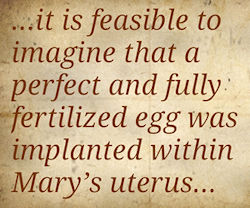We talk about blood a lot. “We are related by blood.” “Blood is thicker than water.” “I gave you my blood, sweat, and tears.” “That makes my blood boil.” You can probably think of more such sayings. These statements are rather common and, as one author said, “It seems we humans are hard-wired to ‘know’ the importance of the life-fluid we call blood.”1
Our obsession with blood originated in the Bible, where we learned killing is expressed as shedding blood. The blood of a sacrificial animal, offered on God’s altar “was its ‘life’ and could stand in place of a human life. That blood essentially signified the life given up in death.”2 The blood of the animal was the substitute price to pay God for people’s sins.
So, this concept of blood’s importance goes all the way back to the time of Genesis, where God rationalized that it is the very life of all creatures. In the Old Testament, blood is shown to be used for atonement, and in the New Testament it clearly teaches that Jesus’ blood serves as atonement for the sins of all humanity.3 God told Moses, “For the life of the body is in its blood. I have given you the blood on the altar to purify you, making you right with the LORD. It is the blood, given in exchange for a life, that makes purification possible,” (Leviticus 17:11, NLT).4
 Not only was this foreshadowing the coming Messiah, who would shed his blood in exchange for all dead and dying human sinners, but God was establishing a life style. God commanded his people to perform sacrifices as offerings for unintentional sins against him. These processes were also a way to maintain a relationship between God and his sinful nation. This way of daily living would symbolically keep the idea of shedding blood in the forefront of all that the Israelites would do.
Not only was this foreshadowing the coming Messiah, who would shed his blood in exchange for all dead and dying human sinners, but God was establishing a life style. God commanded his people to perform sacrifices as offerings for unintentional sins against him. These processes were also a way to maintain a relationship between God and his sinful nation. This way of daily living would symbolically keep the idea of shedding blood in the forefront of all that the Israelites would do.
God went on to say to Moses, “That is why I have said to the people of Israel, ‘You must never eat or drink blood — neither you nor the foreigners living among you. And if any native Israelite or foreigner living among you goes hunting and kills an animal or bird that is approved for eating, he must drain its blood and cover it with earth’,” (Leviticus 17:12-13).
God was indicating that the wage of sin is death, symbolized by the shedding of blood, which should be respected. So, without the shedding of blood, there is no remission of sin. Forgiveness comes not because the penalty of sin is excused, but because it is transferred to a sacrifice (substitute), whose lifeblood is poured out.5 This explains why Jesus’ shed blood on the cross met God’s legal requirement for redemption of all sinners. “For the wages of sin is death, but the free gift of God is eternal life through Christ Jesus our Lord,” (Romans 6:23).
Is sin a poison in the blood?
Since the time of Moses, and up into the first century AD, the sacrifice of animals and their shed blood symbolized a coming Messiah, who would take away their sins forever. And now, since God’s lamb (his son) has been sacrificed, his shed blood pays the price for our sins. This line of logic is just one example of why knowledge in the Old Testament helps us understand the New Testament.
 As a side note concerning blood, Jehovah’s Witnesses (JW) take the message of not eating blood a bit differently than most other Christian religions. If you are a JW, or know someone who is debating this issue, there is another related article that you may find of value. It is titled “Eating Blood & Blood Transfusions — one Christian’s Opinion” and it is listed in References & Notes.6
As a side note concerning blood, Jehovah’s Witnesses (JW) take the message of not eating blood a bit differently than most other Christian religions. If you are a JW, or know someone who is debating this issue, there is another related article that you may find of value. It is titled “Eating Blood & Blood Transfusions — one Christian’s Opinion” and it is listed in References & Notes.6
Because the Bible states ‘the life of the body is in its blood’, another issue is debated within some other Christian sects. That issue is a theory that sin is but a poison in the blood of us humans, which was introduced back in the Garden of Eden, when sin first entered the world.
This idea became a big thought exercise back in the first half of the last century, especially within some Baptist denominations. It still persists in various congregations throughout the world and I’ve been approached about this idea several times.
The idea, or theory, was a common belief among Christians (even including some medical professionals), that sin was transmitted through the blood — somehow, the blood of Adam and Eve was poisoned. That led to the death sentence being passed down to all humankind because of sin in the blood. But that raised the question of how could Jesus have been a sinless man, if he was born from a woman with inherited sin?7
The answer to that question was suggested with the theory, presented by a medical doctor, Martin DeHaan,8 suggesting that while the woman is responsible for the growth of the fetus’ body, only the man’s sperm determines and controls the development of the blood. Therefore, it was thought that the blood comes from only the father, and the poison of sin with it. Basically, the reasoning was “all the blood which is in that child is produced within the child itself as a result of the introduction of the male sperm. The mother contributes no blood at all.”9
This logic implied that the sperm cell, supplied by God to fertilize Mary’s egg cell (or ovum), would have created perfect blood, untainted by sin. Some fundamentalist churches accepted the theory immediately and without question, and many still believe this today.
At the time, it was considered medically reasonable, because a handbook for nurses quoted the following: “When the circulation of the blood begins in the embryo, it remains separate and distinct from the mother.”10
Being a medical doctor, DeHaan cited even more technical references. One obstetrics textbook stated,11 “The fetal and maternal blood do not come into actual contact. They are separated from each other by the walls of the fetal blood vessels and the epithelial layers of the chorionic villae.”12 And another medical text stated, “The fetal blood in the vessels of the chorionic villae at no time gains access to the maternal blood . . . , being separated from one another. . . .”13
In a book he wrote, DeHaan tried to show that sin affected the blood of man, which necessitated the virgin birth of Christ, if he was to be a descendant of Adam and yet a sinless man. So, because he did not have a drop of Adam’s blood in his veins, he did not share in Adam’s sin.14
 Not all Baptists were ‘on board’ with acceptance of this theory and another author presented his own thoughts. “Now it is a secret which God has not seen fit to reveal how depravity is transmitted from the parents to the children. We do know that when a child is conceived in the normal way he is depraved. We know that Christ had the same flesh and blood which we have, yet he was not depraved. This means that neither sin nor depravity are transmitted via blood.”15
Not all Baptists were ‘on board’ with acceptance of this theory and another author presented his own thoughts. “Now it is a secret which God has not seen fit to reveal how depravity is transmitted from the parents to the children. We do know that when a child is conceived in the normal way he is depraved. We know that Christ had the same flesh and blood which we have, yet he was not depraved. This means that neither sin nor depravity are transmitted via blood.”15
Despite some opposition, I can understand how DeHann’s theory could sound reasonable to so many people eighty years ago. But, today, my first problem with his analysis is that it was written before much was known about the more technical aspects of genetics and DNA. In fact, his theory was presented more than twenty years before the scientists Francis Crick, James Watson, and Maurice Wilkins received a Nobel Prize (1962) for discovering the double helical16 structure of DNA.17
More important is the second problem, that this theory has no scriptural evidence to support any such doctrine, and DeHaan had made a lot of assumptions that weren’t backed-up by facts. Today, science knows those assumptions weren’t true. Simply put, his theory is false.
We now know that the closed circulatory system of the fetus transports nutrients and oxygen throughout the body, and provides a barrier to protect the fetus from bacteria and other harmful things. But we also know that it is possible for some toxic substances to still get through that barrier: alcohol, antibiotics, anti-cancer and addictive drugs, tobacco chemicals, and some diseases (like rubella viruses, syphilis, etc.).
If sin isn’t in the blood, how do we get it?
Other than what the Bible says, we just don’t know the technical details of how sin has been handed down to all humans during the last several thousands years. But, we can speculate — it is more likely from genetics, than a poison in the blood. It could be that DNA is the mechanism for inherited sin, and while this molecule is within most cells of the body, it is not contained in mature red blood cells.18
The latest scientific research indicates genetic switches are regulatory elements in DNA to control gene expression. Genetic switches can turn genes on and off.19 Even scientists have now learned how to use synthetic protein coding, using a messenger RNA (mRNA) molecule.20 This is the method now used in developing some Covid vaccines which actually make changes in the body.21 While that is (in my opinion) a reckless experimental approach to disease control, God’s awesome wisdom could have used such knowledge to tweak our DNA with Godly genetic engineering. If so, he alone knows how to switch ‘on’ or ‘off’ hereditary sin.
 Scripture was written so that it could be understood within the education and culture at the time, but there are hints concerning deeper understanding for a future time. One example is given in an article titled “The Science of Sin — is Evil Inherited?” That study addresses original sin, sins of the father, a lesson in genetics from the biblical story of Jacob, along with discussions on DNA and gene expression. See References & Notes for a link.22
Scripture was written so that it could be understood within the education and culture at the time, but there are hints concerning deeper understanding for a future time. One example is given in an article titled “The Science of Sin — is Evil Inherited?” That study addresses original sin, sins of the father, a lesson in genetics from the biblical story of Jacob, along with discussions on DNA and gene expression. See References & Notes for a link.22
God’s ways are so far more advanced than ours that we cannot fathom such technology, and without more advanced knowledge, we can only call it a miracle. But it is feasible to imagine that a sin-free and fully fertilized egg was implanted within Mary’s uterus, instead of just using artificial insemination (sperm only). Mary, having received God’s perfect ‘package’, would than have been a surrogate, but fully growing the fetus and then birthing God’s human son. That would have made Mary the heavenly appointed representative human mother, with God as the father. That’s just my opinion, of course.
Conclusion
The song related to the theme of this article is “This Blood” sung by West Coast Choir. This group represents the West Coast Bible College (affiliated with the Independent Fundamentalist Baptist tradition) located in Landcaster, California, USA. Selected lyrics are below and the music video is listed in References & Notes.23
 There is a blood that cost a life
There is a blood that cost a life
That paid my way, Death its price
When it flowed down from the cross
My sins were gone, my sins forgot
There is a blood that sights the blind
That heals the sick, the lonely finds
It has the power to free the bound
As chains they fall upon the ground
![]()
Copyright © 2021, Dr. Ray Hermann
OutlawBibleStudent.org
→ Leave comments at the end, after ‘References & Notes’.
You can see our basic rules for comments by clicking “The Fine Print” on the top menu bar. Your email address will NOT be published.
Reference & Notes
- Powell, Barnabas, “Life Is In the Blood”, (Faith Encouraged, 5 April 2021), https://blogs.ancientfaith.com/faithencouraged/2021/04/life-is-in-the-blood/
- Rooker, Mark F., CSB Apologetics Study Bible, (Nashville TN: Holman Bible Publishers, 2017), p. 146.
- Matthews, Kenneth, CSB Study Bible: Notes, (Nashville TN: Holman Bible Publishers, 2017), pp. 183-184.
- Unless otherwise noted, all scripture is from Holy Bible, New Living Translation, (Carol Stream, IL: Tyndale House Foundation, 2015). Used with permission.
- MacDonald, William, Believer’s Bible Commentary: Old and New Testaments, (Ed.) Arthur Farstad, (Nashville TN: Thomas Nelson, 1995), p. 154.
- Hermann, Ray, “Eating Blood & Blood Transfusions — one Christian’s Opinion”, (OBS, 18 October 2020), https://outlawbiblestudent.org/eating-blood-blood-transfusions-one-christians-opinion/
- Settlemoir, J.C., “An Examination of ‘The Chemistry of the Blood”, (NTBaptist-Lizton Organization, retrieved 9 April 2021), http://ntbaptist-lizton.org/articles/JC-Settlemoir-The-Chemistry-of-the-Blood.pdf
- Martin Ralph DeHaan (1891 – 1965): American medical doctor (MD), author, church pastor, founder and broadcaster on the global Radio Bible Class program, and the co-editor of a monthly devotional magazine titled Our Daily Bread.
“M. R. DeHaan”, (Sword of the Lord Publishers, retrieved from ‘WayBackMachine’ on 11 April 2021), https://web.archive.org/web/20090122142830/http://www.swordofthelord.com/biographies/DeHaanMR.htm - DeHaan, Martin R., “The Life is in the Blood”, Sermon #4 on ‘The Chemistry of the Blood’, (Radio Bible Class Ministries, Grand Rapids, MI, retrieved 10 April 2021), http://bibleone.net/sermon_4.htm
- Zabriskie, Louise, Nurses Handbook of Obstetrics, 5th ed., (Philadelphia: J.B. Lippincott Company, 1937), p. 75.
- Howell, William H., (Ed.), An American Textbook of Physiology, 2nd ed., (Philadelphia: W.B. Saunders & Company, 1900-1901), vol. 2, pp. 885-886.
- chorionic villi: The finger-like projections from the chorion into the wall of the womb at the site at which the placenta is developing. Since both the chorionic villi and the embryo are derived from the same fertilized ovum a sample of the former provides material for genetic studies of the latter.
“Medical Dictionary”, (The Free Dictionary by Farlex, retrieved 11 April 2021), https://medical-dictionary.thefreedictionary.com/chorionic+villi - Hoffman, Barbara, et al., Williams Practice of Obstetrics, 3rd ed., (New York: McGraw Hill Education, 2016), p. 133.
- DeHaan, M. R., The Chemistry of the Blood, (Grand Rapids MI: Zondervan Publishing, 1943 [renewed copyright 1981, R. Haaksma]), p. 17-18.
- Settlemoir, J. C., “An Examination of ‘The Chemistry of the Blood”, (NTBaptist-Lizton Organization, retrieved 9 April 2021), http://ntbaptist-lizton.org/articles/JC-Settlemoir-The-Chemistry-of-the-Blood.pdf
- “Who Discovered DNA”, (Explorable, retrieved 23 March 2021), https://explorable.com/who-discovered-dna
- DNA: Deoxyribonucleic acid; The genetic information carried in the molecule called DNA determines every inherited physical characteristic of every living thing.
“DNA” (Encyclopedia Britannica, retrieved 23 March 2021), https://www.britannica.com/science/DNA - Dey, Ronit, “Do all cells have DNA? Do all body cells have the same DNA?” (Only Zoology, retrieved 16 April 2021), https://onlyzoology.com/do-all-cells-have-dna-do-all-body-cells-have-the-same-dna/
- “Genetic Switches”, (Bio Interactive, retrieved 13 April 2021), https://www.biointeractive.org/classroom-resources/genetic-switches
- “Messenger RNA”, (Encyclopedia Britannica, 6 May 2009), https://www.britannica.com/science/messenger-RNA/additional-info#history
- Vaccines using messenger RNA (mRNA) technology are like computer operating systems. If DNA is the storage, then mRNA is the software, and the synthetic protein produced is the application.
“mRNA Platform: Enabling Drug Discovery & Development”, (Moderna, Moderna Inc. [vaccine producer’s corporate website], retrieved 13 April 2021), https://www.modernatx.com/mrna-technology/mrna-platform-enabling-drug-discovery-development - Hermann, Ray, “The Science of Sin — is Evil Inherited?” (OBS, 8 June 2020), https://outlawbiblestudent.org/the-science-of-sin-is-evil-inherited/
- “This Blood”, Artist: West Coast Choir (of West Coast Bible College, Landcaster CA, USA); Choir Director: John Williams; Video Director, Jeremy Lofgren, uploaded 1 April 2021; (song copyright 2009 by Kindred Joy Music) – MUSIC VIDEO: https://youtu.be/deyTg1YM3Rc


1 thought on “Life is in the Blood: Leviticus 17:11 — Is Sin in the Blood, too?”